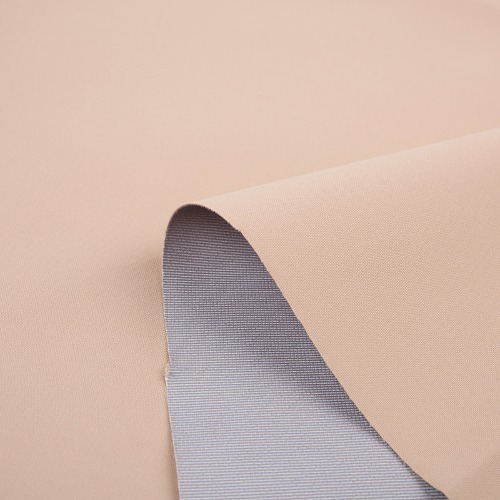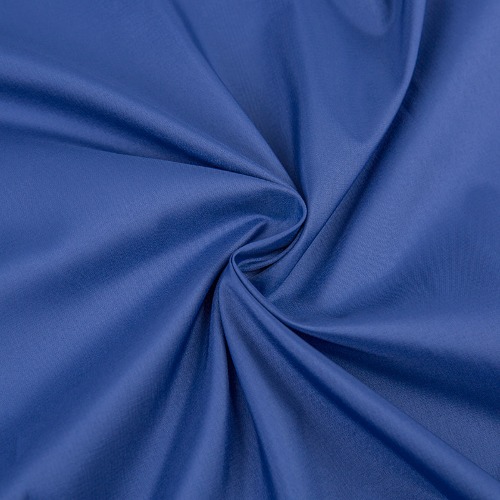No. 116, Building 7, Boutique Commercial Area, Shengze Town, Wujiang District, Suzhou City, China.
1.What is 300T Polyester Pongee Fabric?
300T Polyester Pongee Fabric is 300T polyester Taff fabric. "300T" means that the sum of the fabric warp and weft density is about 300 pieces/inch, which is an important indicator used by the textile industry to measure the tightness of the fabric; "Polyester" refers to polyester, which is what we often call polyester, which is the main material of the fabric; "Pongee" comes from French and refers specifically to a fabric with plain weave structure in the textile field. The fabric is made of ultrafine polyester filaments as raw materials and is made through multiple processes such as warping, weaving, dyeing, and post-organization. When weaving, a precision water jet loom is used to make the warp and weft yarns tightly interwoven, giving the fabric a flat and delicate appearance.
300T Polyester Pongee Fabric has a light texture and a smooth feel. It has good waterproof, windproof and wear resistance. It also has good wrinkle resistance, is not easy to deform, and is easy to take care of. Due to its tight structure, water vapor is difficult to penetrate and is often used as a material for making raincoats and outdoor windbreakers. Its excellent wear resistance makes it also popular in the fields of luggage linings, tent fabrics, etc. In addition, the fabric has excellent dyeing performance and can be produced through printing, coating, embossing and other post-organization processes to present rich colors and unique textures, meeting different design needs. In the field of clothing, it is often used to make sports jackets and sunscreens; in home decoration, it can be made into curtains and tablecloths; in the industrial field, it can also be used as instrument dust covers, automobile covers, etc. It is a cost-effective and versatile fabric.

2.300T Polyester Pongee Fabric has what are the prominent features?
2.1 Why is it called the "King of Waterproof"?
The 300T Polyester Pongee Fabric is known as the "King of Waterproofing" and is derived from its tight structure and special aftertreatment. "300T" means that the weft and weft density is extremely high, the pores between the yarns are extremely small, and water vapor is difficult to penetrate; in addition, the fabric is treated with a waterproof coating, such as a PU (polyurethane) coating, forming a continuous waterproof film on the surface of the fiber, further preventing moisture from invading. In the outdoor products market, it is indeed very competitive and is widely used in windbreaker, tent, raincoat and other products. However, whether the market share can continue to increase is also affected by competition for other new waterproof materials and diversified consumer demand. For example, if emerging materials have lighter and softer properties on the basis of waterproofing, they may impact their market position.
2.2 How breathable is this fabric?
The high-density structure does have a certain impact on the breathability of the 300T Polyester Pongee Fabric. The tight yarn arrangement and waterproof coating block moisture while also limiting air circulation. To solve this problem, manufacturers often use microporous coating technology to create tiny breathable holes on the coating, or develop moisture-permeable PU films to enable the fabric to improve breathable performance to a certain extent while maintaining waterproofness. Nevertheless, when users choose products that use the fabric, they still need to weigh the waterproofness and comfort. For example, in high-intensity outdoor sports scenarios, water resistance is more important; while in daily light outdoor activities, the demand for breathability is higher.
2.3 Is its durability and tear resistance better than other fabrics?
With the high strength and wear resistance of the polyester itself, as well as its tight structure, the 300T Polyester Pongee Fabric performs excellent durability and tear resistance. During long-term use, it is not easy to wear or pill; it can also maintain structural integrity when facing harsh environments such as scraping branches and accidentally pulling. Compared with some ordinary fabrics, such as cotton canvas, their tear resistance is several times higher. However, compared with professional special fabrics such as ultra-high molecular weight polyethylene, the performance of the 300T Polyester Pongee Fabric still has room for improvement in extremely harsh environments, such as polar adventure.
2.4 What is the environmental performance? Is it sustainable?
The traditional 300T Polyester Pongee Fabric is based on polyester made of petrochemical raw materials. The production process has high energy consumption and high carbon emission problems, and is not easy to degrade, and has poor environmental protection. But in recent years, the industry has also been actively improving. Some manufacturers use recycled polyester as raw material
to recycle and reprocess waste plastic bottles, old clothes, etc., to reduce dependence on native resources and reduce carbon footprint; in production processes, water-saving dyeing and low-energy-consuming weaving technologies are promoted. However, the sorting and processing costs of recycling polyester are relatively high, and secondary pollution may occur during the recycling process. Its sustainability still requires the industry to further optimize the production process and improve the recycling system to meet consumers' growing environmental protection needs.
3. In the textile industry, how widespread are the 300T Polyester Pongee Fabric application scenarios?
3.1 Why do it occupies an important position in sportswear and outdoor equipment?
In the fields of sportswear and outdoor equipment, the 300T Polyester Pongee Fabric occupies an important position with its excellent waterproof and windproof performance. The tight fabric structure and waterproof coating can effectively resist wind and rain. Even in the face of severe weather such as heavy rain and strong winds, it can provide good protection for the wearer and meet the needs of most extreme sports enthusiasts. At the same time, the fabric is wear-resistant and tear-resistant. In high-intensity sports such as rock climbing and mountain climbing, it is not easy to be damaged by friction or scratches, and ensures the service life of the equipment. Therefore, it is often used to make windbreakers, mountaineering bags, tents, etc.
3.2 Are there any breakthroughs in the field of home decoration?
In the field of home decoration, the 300T Polyester Pongee Fabric has also achieved a breakthrough. Although the fabric itself is hard, it can achieve the softness suitable for home use after special soft finishing. Its excellent durability makes it an ideal choice for curtains, sofas and bedding. It not only does not fade or deform, but also has good stain resistance, which is easy to clean and take care of, and meets the needs of daily use scenarios of the family.
3.3 Is it suitable for the high-end fashion market?
As for the high-end fashion market, the 300T Polyester Pongee Fabric also shows certain potential. Through innovative post-tidying processes, such as calendering, coating embossing, etc., the fabric can be given a unique texture and gloss, satisfying the pursuit of material novelty by some high-end fashion designers. However, compared with the luxury and flowing traditional silk and the natural skin-friendly cotton cloth, there is still a gap in texture and comfort. It is currently more used in functional fashion items. If you want to compete comprehensively in the high-end fashion field, you still need to further explore in improving texture, comfort and giving cultural connotations.

4.300T Polyester Pongee Fabric production costs and market pricing?
4.1 Why is the production cost relatively low?
The production cost of 300T Polyester Pongee Fabric is relatively low, mainly due to both raw materials and process. In terms of raw materials, it is made of polyester fiber (polyester). As a downstream product of the petrochemical industry, polyester has mature production technology, sufficient raw material supply and stable price, and is cheaper than natural fibers or high-performance special fibers. In terms of manufacturing process, the 300T Polyester Pongee Fabric adopts a plain weaving structure, and the weaving process can be completed using a water jet loom. Compared with the complex jacquard and double-layer weaving process, the equipment investment and production are less difficult, and the production efficiency is high. It can achieve large-scale mass production and effectively share the unit cost. Compared with other high-density fabrics, such as high-density nylon fabrics, often requiring special weaving equipment and complex post-treatment, the 300T Polyester Pongee Fabric has a more cost-effective process advantage.
4.2 Does market prices reflect their value?
From the perspective of market prices, the pricing of the 300T Polyester Pongee Fabric basically reflects its value. Because of its low production cost and affordable prices in the market, it is often used in the production of products in the mid- and low-end consumer markets, such as outdoor clothing, economical tents of fast fashion brands. Faced with the trend of consumers pursuing cost-effectiveness, this fabric has a reasonable market positioning and can provide practical functions such as waterproofing and wear resistance at a lower price to meet the public's demand for functional textiles. However, as consumers increase their quality and environmental protection requirements, relying solely on low-price strategies may limit their development in the mid-to-high-end market, and enterprises need to give more added value to their products through process upgrades.
4.3 Does global supply chains affect their price fluctuations?
The global supply chain has a significant impa
ct on price fluctuations in the 300T Polyester Pongee Fabric. On the one hand, the raw material prices of polyester fibers are affected by fluctuations in the oil market, and the rise and fall of international oil prices will be directly transmitted to the fabric production cost; on the other hand, fabric production is highly dependent on production bases such as Asia, especially in China and Vietnam. If there are problems such as policy adjustments, natural disasters, and labor shortages in these regions, it will affect the stability of production capacity and supply, and thus trigger price fluctuations. In addition, factors such as international trade frictions and changes in logistics costs will also affect their final market prices through the supply chain.
5. What are the advantages and disadvantages of the 300T Polyester Pongee Fabric for manufacturers and consumers?
5.1 What is the core reason why manufacturers choose this fabric?
For manufacturers and consumers, the 300T Polyester Pongee Fabric has distinct advantages and disadvantages. The core reason why manufacturers choose this fabric is not that it has high technical content, but that it is easy to process and has outstanding overall benefits. From the perspective of raw materials, polyester fiber has a wide range of sources and stable prices, which can ensure the stability of the supply chain; in the processing step, it adopts a plain weave structure and is adapted to common water jet looms. The production process is simple and does not require complex equipment and difficult processes, which reduces the technical threshold and equipment investment cost. At the same time, its large-scale mass production characteristics greatly improve production efficiency and shorten the lead time, which helps to quickly respond to market demand and increase profit margins.
5.2 How do consumers say it?
Consumers have mixed reviews of the 300T Polyester Pongee Fabric. Its waterproof and lightweight advantages are highly recognized. It is often used to make outdoor equipment and sportswear. It can effectively resist wind and rain during rainy days or outdoor activities. The fabric is light and thin, so you can wear and move freely. However, the problem of insufficient breathability is also obvious. The tight structure and waterproof coating limit the air circulation, making it easy to feel stuffy when worn for a long time. However, in some specific scenarios, such as short-term high-intensity exercise and bad weather travel, consumers value waterproof performance and are willing to endure the problem of insufficient breathability; but in daily leisure scenarios, this disadvantage may affect consumer choice.
5.3 Is this fabric easy to maintain and clean?
The 300T Polyester Pongee Fabric has obvious advantages in maintenance and cleaning. It is not easy to get stains and has strong wrinkle resistance, so it is not easy to leave wrinkles even if it is folded and stored. In daily use, you only need to use ordinary detergent to gently machine or hand wash to avoid using strong bleach and avoid exposure to the sun when drying, so as to maintain the performance and appearance of the fabric. This easy-to-maintain feature meets the modern consumers' pursuit of convenient living needs and has also become one of the important factors that attract consumers to buy.
6. In the future, what is the technological development direction of 300T Polyester Pongee Fabric?
6.1 Innovation in environmentally friendly production processes
In the future, the 300T Polyester Pongee Fabric is expected to usher in a more environmentally friendly production process upgrade. At present, traditional production relies on petrochemical raw materials and has high energy consumption. In the future, bio-based polyester may be gradually used to replace some petrochemical raw materials, extract raw materials from renewable resources such as corn and sugarcane, and reduce their dependence on non-renewable resources. In the dyeing process, new technologies such as anhydrous dyeing and supercritical carbon dioxide dyeing will be widely used to reduce wastewater discharge. At the same time, recycling and reuse technology will continue to be optimized. Through more efficient sorting and depolymerization processes, the discarded 300T Polyester Pongee Fabric will be remade into fibers to form a closed-loop production, making this fabric more in line with the requirements of sustainable development.
6.2 High-tech promotes performance upgrades
Nanotechnology and smart textile technology are most likely to be used in the 300T Polyester Pongee Fabric. Nanocoating technology can form a nano-level protective layer on the surface of the fabric, so that the fabric can further improve oil and stain resistance while maintaining its original waterproof performance without affecting breathability; by combining intelligent sensing materials with the fabric, it can be given functions such as monitoring body tempera
ture and humidity, and is used to make smart sportswear and provide real-time feedback on the wearer's physical condition. In addition, with the help of 3D textile technology, the internal structure of the fabric can be optimized, allowing it to enhance strength and toughness while reducing weight, meeting higher performance needs.
6.3 Expanding potential in emerging fields
In the aerospace field, although the current performance of the 300T Polyester Pongee Fabric is currently different from professional requirements, after the performance upgrade, its lightweight and wear-resistant characteristics may be used to make spacecraft interior decorative materials, lightweight protective pads, etc. In the field of medical protection, if antibacterial nanotechnology is combined, it can effectively inhibit bacterial growth and is expected to be used to make surgical isolation suits, medical bed sheets, etc.; through intelligent textile technology, it can also be used in patient care clothing to monitor vital signs in real time. However, to enter these emerging fields, the 300T Polyester Pongee Fabric also needs to pass rigorous testing and certification in terms of performance, security, etc.
The 300T Polyester Pongee Fabric is undoubtedly one of the focus of attention in the textile industry in recent years. It has won favor in multiple fields for its high density, water resistance and durability. However, with the changes in market demand, the upgrading of fabric production technology, and consumers' environmental protection requirements, this kind of fabric also faces opportunities and challenges.
 English
English
 中文简体
中文简体
 Español
Español


